The Library Project
Here begins The Library Project, the backbreaking saga of How I Put My Books
Where I Could Find Them.
26 March 2002: The easiest way to organize a library is to move house.
As you unpack boxes in your new home, you put each book with others just like
it. That is the theory, which I imagine has only rarely been put into practice,
and then only at the Morgan level. In the event that you cannot move, then you
buy a new bookshelf, or, as I have just done, you have a bookshelf made to
order. And as long as you're having it built to order, why not tart it up? I'll
tell you why not, later, if you still need to have it spelled out for you.
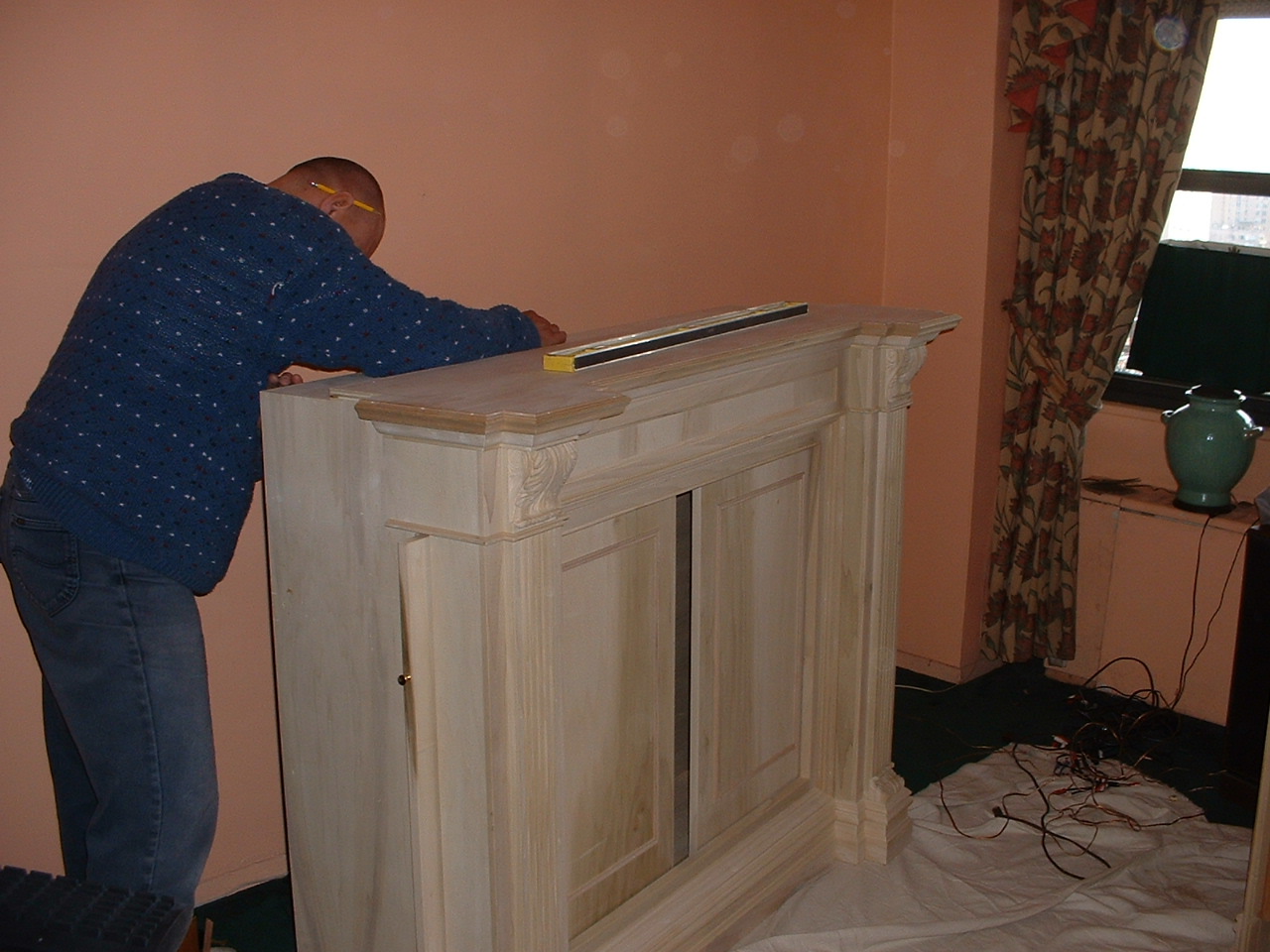 On Thursday, 21 March, two carpenters from the Little Wolf Cabinet Shop, a local establishment, arrived with six bulky
components. My cousin, Tim Waligore, and I had just finished clearing the living
room of all the furniture that couldn't be pushed to one side. The first piece
to come through the doorway did not look much like a bookshelf. It looked like a
fake fireplace, a fake fireplace with sliding doors where the hearth ought to be.
One fine day, a snazzy plasma display would be mounted behind those doors. Right
away, though, the generous mantelpiece would lend a gracious air to a very
undistinguished room.
On Thursday, 21 March, two carpenters from the Little Wolf Cabinet Shop, a local establishment, arrived with six bulky
components. My cousin, Tim Waligore, and I had just finished clearing the living
room of all the furniture that couldn't be pushed to one side. The first piece
to come through the doorway did not look much like a bookshelf. It looked like a
fake fireplace, a fake fireplace with sliding doors where the hearth ought to be.
One fine day, a snazzy plasma display would be mounted behind those doors. Right
away, though, the generous mantelpiece would lend a gracious air to a very
undistinguished room.
You will note that the wood has not
been finished. As a rule, the Little Wolf Cabinet Shop leaves finishing up to
the consumer, who in most cases is working with an architect or contractor.
Eventually, when it's time to repaint the entire room, I'll hire a painter to do
the job. My current plan is to paint the mantelpiece a glossy off-white, the
color of choice wherever gracious airs are sought. As for the sliding doors, it
would probably be best to paint them the same color as the mantelpiece, but by
the time I get around to hiring a painter, I may have succumbed to cleverer
impulses, such as faux marble (which would require a specialist painter). A good
friend of ours, Marty Miller, almost persuaded me that we ought to rig up a sort
of real-life replica of that Magritte painting with the locomotive steaming out
of the fireplace. But the sliding doors would would make this hard to mount, and
the room is really not large enough to accommodate such pleasantries. We'll see.
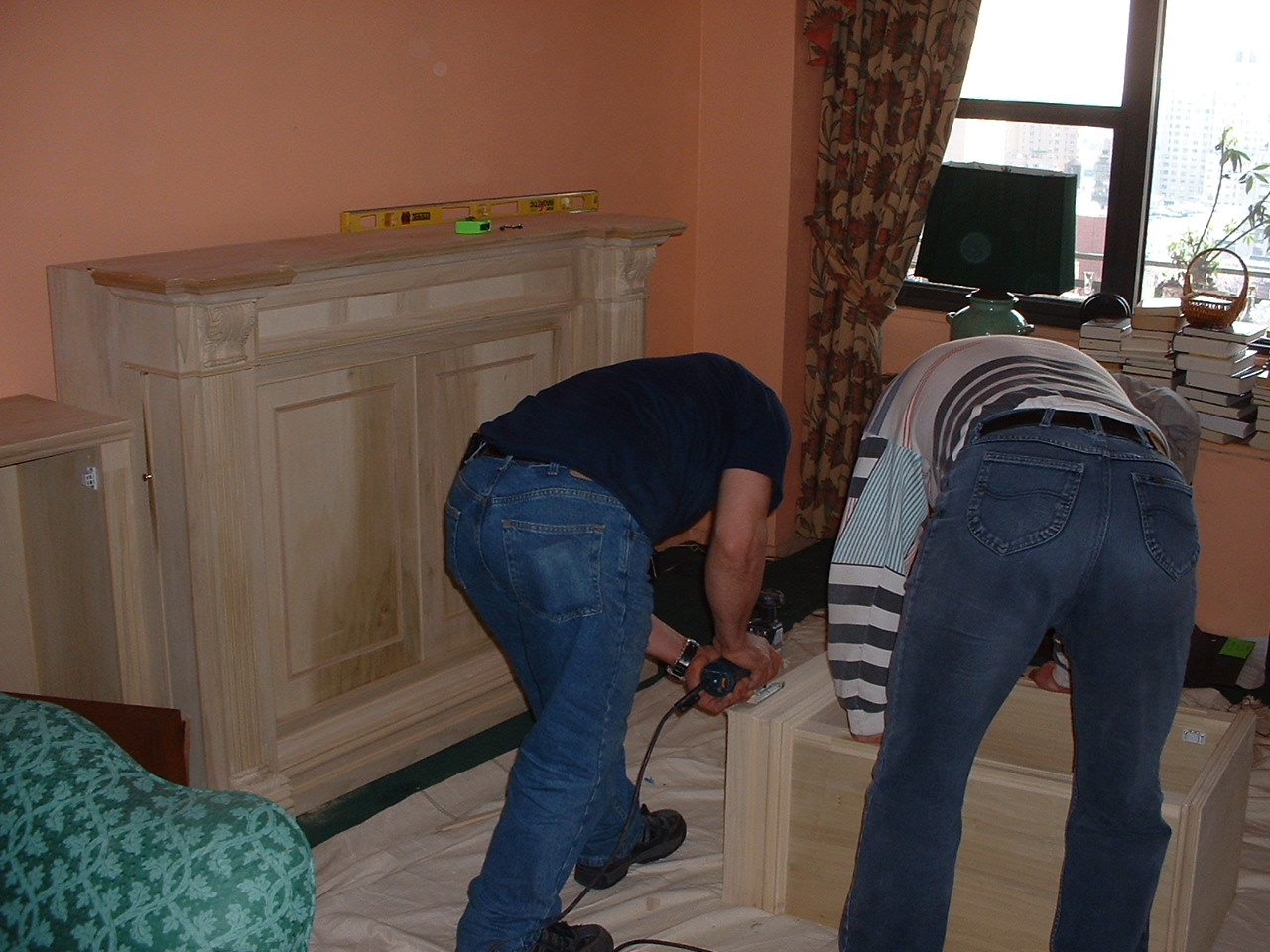 Here
we see the carpenters working on the module that will house the right-hand
speaker of the living-room stereo. It was perhaps unwise to have these modules
built to house twelve year-old Klipsch speakers, but then there are plenty of
excellent, slightly smaller speakers, or at least I hope there will be when the
time comes to replace mine.
Here
we see the carpenters working on the module that will house the right-hand
speaker of the living-room stereo. It was perhaps unwise to have these modules
built to house twelve year-old Klipsch speakers, but then there are plenty of
excellent, slightly smaller speakers, or at least I hope there will be when the
time comes to replace mine.
The left-hand speaker module has already been fitted into
place, its base and kick plate shaved to level and a length of speaker wire
slipped through an unnervingly small hole - that wire had better hold up! The
right-hand module required a lot more work, because in addition to the levelling,
the workers had to cut out holes that would give me access to a pair of electric
sockets and a telephone jack. I'm not sure what good this access will do me,
since I don't think I'll be able to run any new lines to either. But we'll see,
right? The fireplace module, in its turn, has been supplied with a power strip
and a length of coaxial cable. I won't need them for some time, budgets being
budgets.
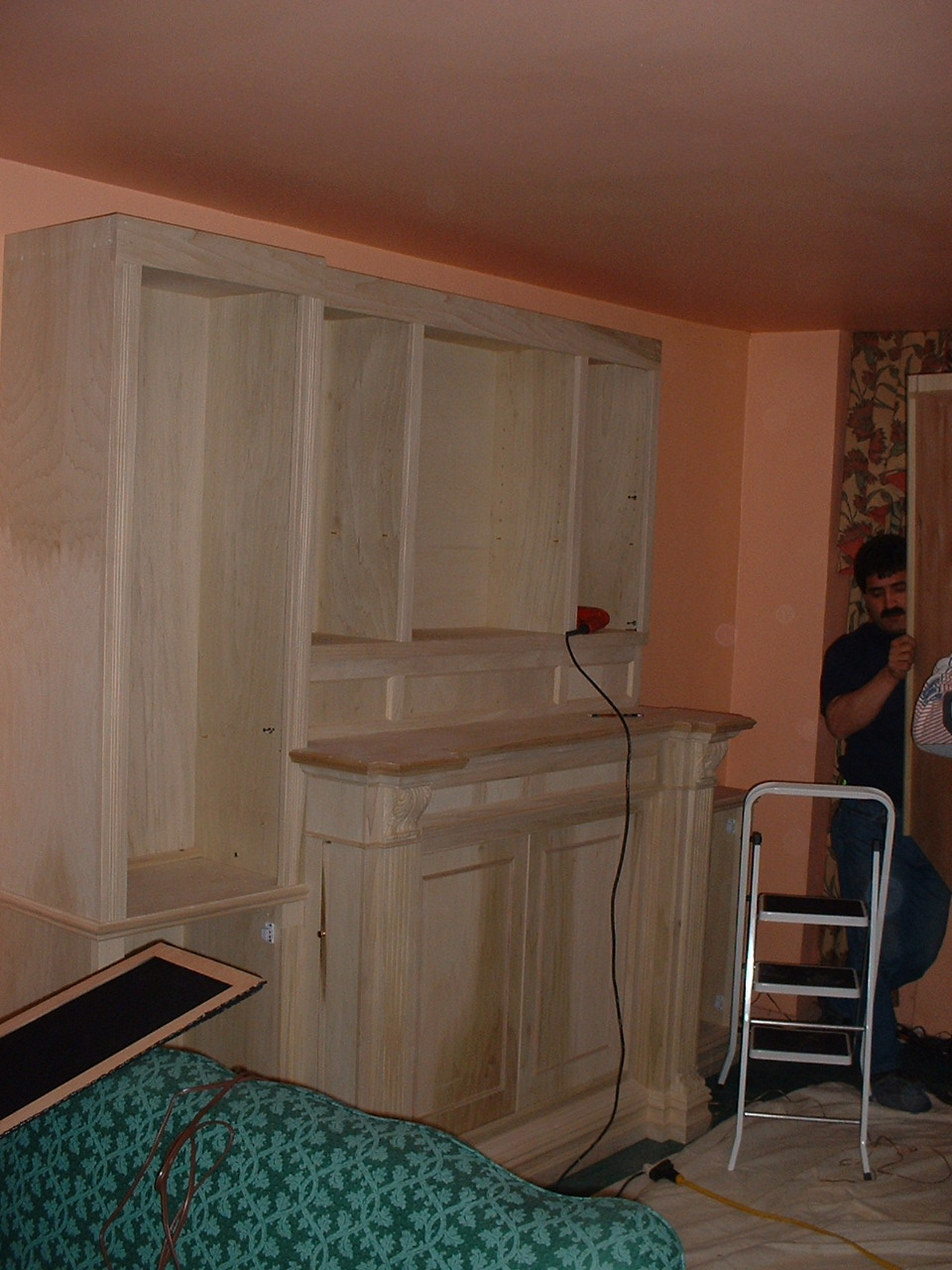 This,
minus a nice bit of cornice on top, and a bookshelf mirroring the one at
the near left, is it. This is it? This is my new bookshelf, designed - so I
thought - to house the books piled up next to the floor in the other room? To
house those books, that is, and the ones that were in the old bookcase
that this fancy-schmancy fake fireplace unit replaced? But I had already
weathered the shock stage long before I snapped this picture. I had seen the
unit, in one piece, at the cabinetmaker's. I had known then, mortally, that my
very elementary, sub-CAD design had misled the designer who drew up the plans
according to which lumber was measured twice and cut once. As always, I had
wanted Everything. In this case, Everything included a handsome mantelpiece and
a breakfront bookcase. I got both, really, except that the center block of
shelving, the part over the mantelpiece, was supposed to break forward,
so that I could stack two rows of books on each shelf. That would have either
cut seriously into the mantelpiece top or pushed the whole unit farther out into
the living room, beyond my carefully calculated twenty inches. Instead, of
course, the designer did the sensible, handsome thing, and broke the central
block backward - hard to tell in this picture, but you'll see what I mean
in a minute. My consolation? Knowing, as I do from decades of frustration, that
no bookshelf is ever large enough. None.
This,
minus a nice bit of cornice on top, and a bookshelf mirroring the one at
the near left, is it. This is it? This is my new bookshelf, designed - so I
thought - to house the books piled up next to the floor in the other room? To
house those books, that is, and the ones that were in the old bookcase
that this fancy-schmancy fake fireplace unit replaced? But I had already
weathered the shock stage long before I snapped this picture. I had seen the
unit, in one piece, at the cabinetmaker's. I had known then, mortally, that my
very elementary, sub-CAD design had misled the designer who drew up the plans
according to which lumber was measured twice and cut once. As always, I had
wanted Everything. In this case, Everything included a handsome mantelpiece and
a breakfront bookcase. I got both, really, except that the center block of
shelving, the part over the mantelpiece, was supposed to break forward,
so that I could stack two rows of books on each shelf. That would have either
cut seriously into the mantelpiece top or pushed the whole unit farther out into
the living room, beyond my carefully calculated twenty inches. Instead, of
course, the designer did the sensible, handsome thing, and broke the central
block backward - hard to tell in this picture, but you'll see what I mean
in a minute. My consolation? Knowing, as I do from decades of frustration, that
no bookshelf is ever large enough. None.
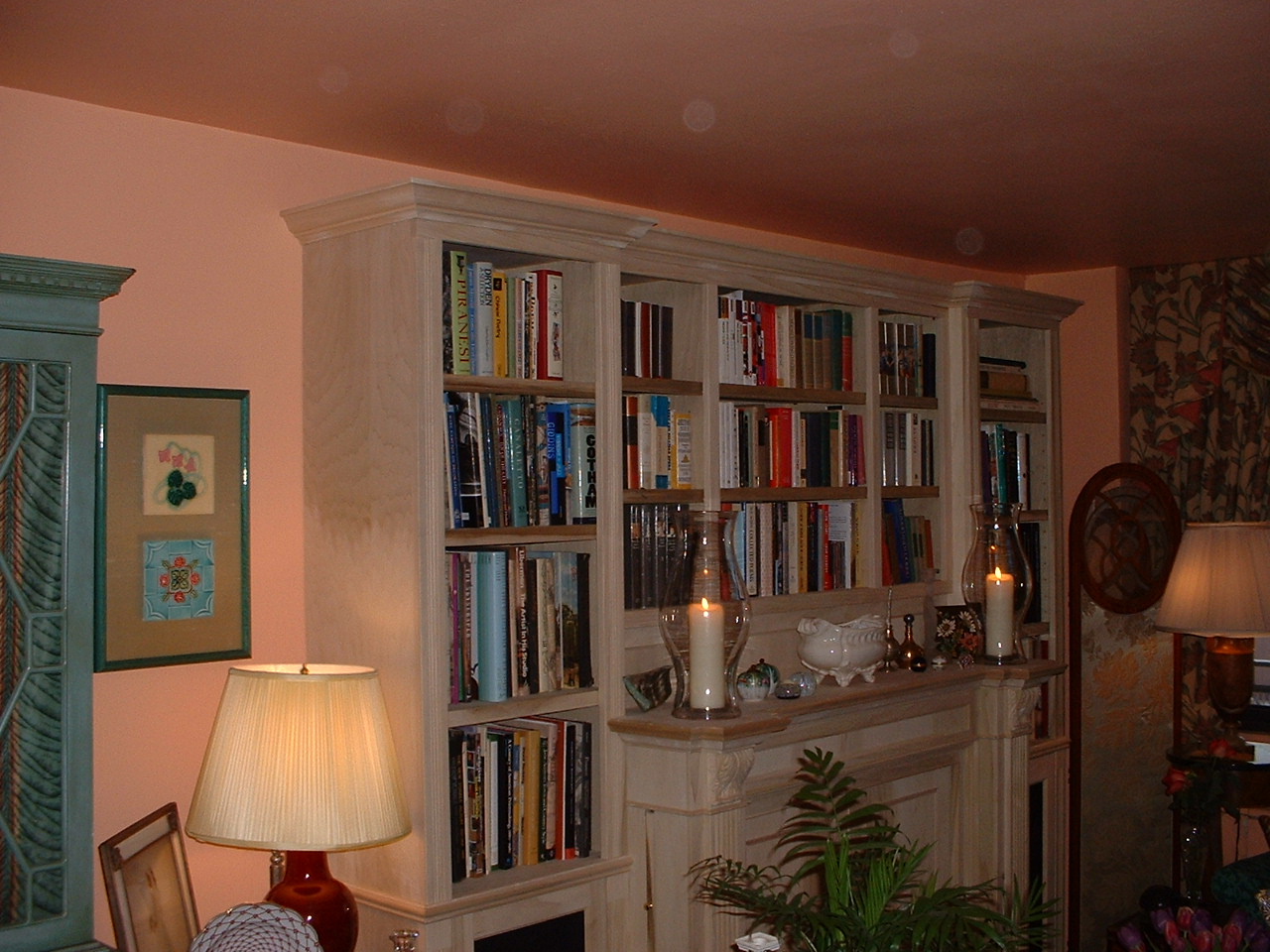
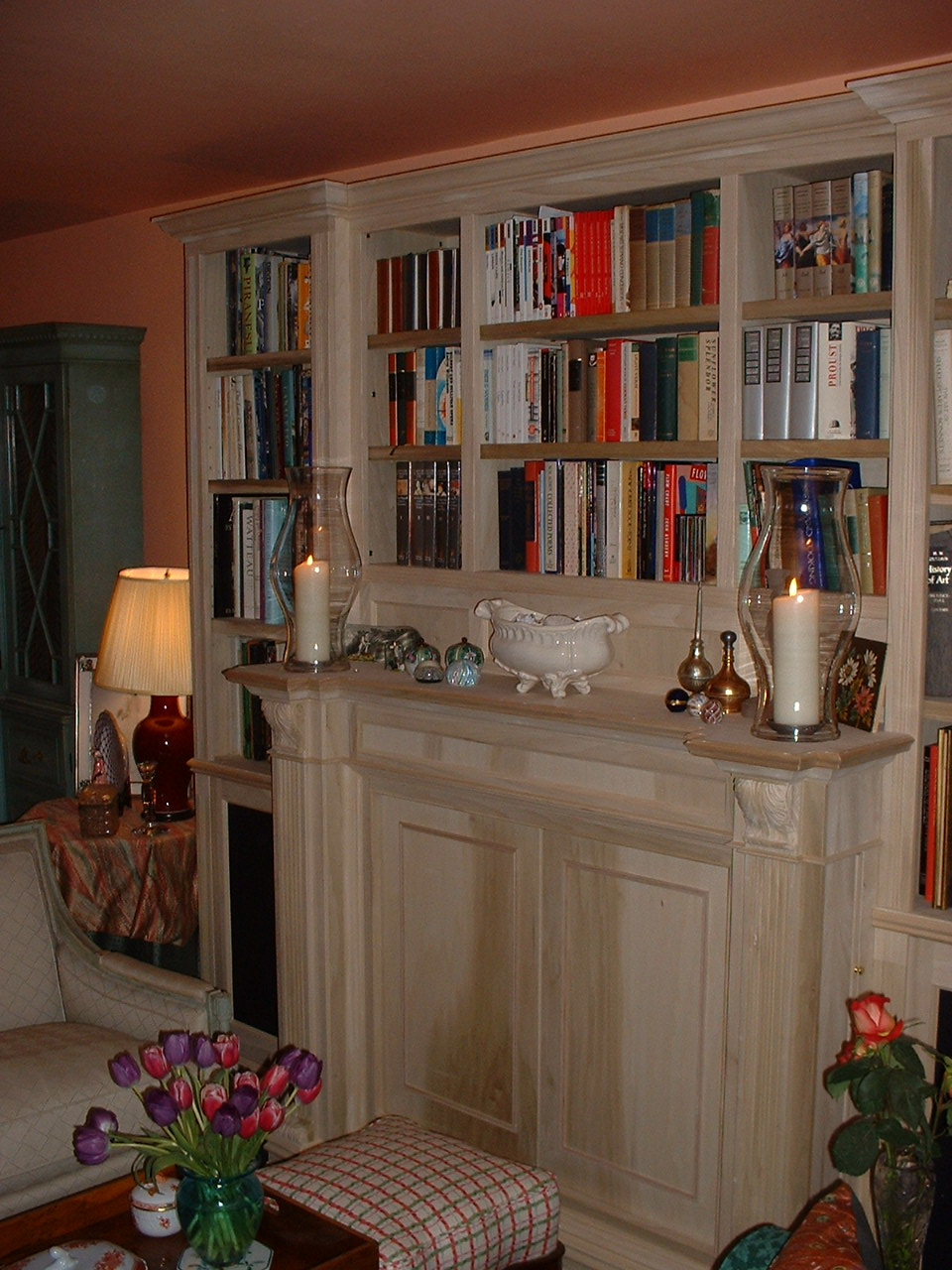 Order restored.
Order restored.
The snaps to the right and left are barely hours old. I took
a few intermediate shots, but I got rid of them because the candles weren't
lighted. No, the real reason is this: they showed how much - how little - empty
shelving there was after I put up all the books that had been in the old
bookcase, which, by the way, I'm sorry I didn't take a picture of. It was a
plain but foursquare, simple but sturdy six-footer, constructed by one of the
entry-level bookshelf retailers, that a former associate of Kathleen's, long
since returned to her native Boston, gave to us on condition that we pay to have
it moved across town ($60). Olivia's bookshelf served us very well for nearly
twenty years, spending about half that time at our house on Candlewood Lake and
two years on the balcony here in New York. When Kathleen decided that she
couldn't stand to look at it out the bedroom window any longer, and had it
replaced with a hutch (from another entry-level supplier), I was about to drag
it down the hall to the service elevator for recycling, but I needed the shelf
space too badly, so it spent a final nine months in our living room, where it
looked as out of place as what you see in these pictures, but in the other
direction.
When I think what this hulk would have held if the fireplace
were shelving!
Permalink
Copyright (c)
2004 Pourover Press
Write
to me Portico
 On Thursday, 21 March, two carpenters from the Little Wolf Cabinet Shop, a local establishment, arrived with six bulky
components. My cousin, Tim Waligore, and I had just finished clearing the living
room of all the furniture that couldn't be pushed to one side. The first piece
to come through the doorway did not look much like a bookshelf. It looked like a
fake fireplace, a fake fireplace with sliding doors where the hearth ought to be.
One fine day, a snazzy plasma display would be mounted behind those doors. Right
away, though, the generous mantelpiece would lend a gracious air to a very
undistinguished room.
On Thursday, 21 March, two carpenters from the Little Wolf Cabinet Shop, a local establishment, arrived with six bulky
components. My cousin, Tim Waligore, and I had just finished clearing the living
room of all the furniture that couldn't be pushed to one side. The first piece
to come through the doorway did not look much like a bookshelf. It looked like a
fake fireplace, a fake fireplace with sliding doors where the hearth ought to be.
One fine day, a snazzy plasma display would be mounted behind those doors. Right
away, though, the generous mantelpiece would lend a gracious air to a very
undistinguished room.  Here
we see the carpenters working on the module that will house the right-hand
speaker of the living-room stereo. It was perhaps unwise to have these modules
built to house twelve year-old Klipsch speakers, but then there are plenty of
excellent, slightly smaller speakers, or at least I hope there will be when the
time comes to replace mine.
Here
we see the carpenters working on the module that will house the right-hand
speaker of the living-room stereo. It was perhaps unwise to have these modules
built to house twelve year-old Klipsch speakers, but then there are plenty of
excellent, slightly smaller speakers, or at least I hope there will be when the
time comes to replace mine.  This,
minus a nice bit of cornice on top, and a bookshelf mirroring the one at
the near left, is it. This is it? This is my new bookshelf, designed - so I
thought - to house the books piled up next to the floor in the other room? To
house those books, that is, and the ones that were in the old bookcase
that this fancy-schmancy fake fireplace unit replaced? But I had already
weathered the shock stage long before I snapped this picture. I had seen the
unit, in one piece, at the cabinetmaker's. I had known then, mortally, that my
very elementary, sub-CAD design had misled the designer who drew up the plans
according to which lumber was measured twice and cut once. As always, I had
wanted Everything. In this case, Everything included a handsome mantelpiece and
a breakfront bookcase. I got both, really, except that the center block of
shelving, the part over the mantelpiece, was supposed to break forward,
so that I could stack two rows of books on each shelf. That would have either
cut seriously into the mantelpiece top or pushed the whole unit farther out into
the living room, beyond my carefully calculated twenty inches. Instead, of
course, the designer did the sensible, handsome thing, and broke the central
block backward - hard to tell in this picture, but you'll see what I mean
in a minute. My consolation? Knowing, as I do from decades of frustration, that
no bookshelf is ever large enough. None.
This,
minus a nice bit of cornice on top, and a bookshelf mirroring the one at
the near left, is it. This is it? This is my new bookshelf, designed - so I
thought - to house the books piled up next to the floor in the other room? To
house those books, that is, and the ones that were in the old bookcase
that this fancy-schmancy fake fireplace unit replaced? But I had already
weathered the shock stage long before I snapped this picture. I had seen the
unit, in one piece, at the cabinetmaker's. I had known then, mortally, that my
very elementary, sub-CAD design had misled the designer who drew up the plans
according to which lumber was measured twice and cut once. As always, I had
wanted Everything. In this case, Everything included a handsome mantelpiece and
a breakfront bookcase. I got both, really, except that the center block of
shelving, the part over the mantelpiece, was supposed to break forward,
so that I could stack two rows of books on each shelf. That would have either
cut seriously into the mantelpiece top or pushed the whole unit farther out into
the living room, beyond my carefully calculated twenty inches. Instead, of
course, the designer did the sensible, handsome thing, and broke the central
block backward - hard to tell in this picture, but you'll see what I mean
in a minute. My consolation? Knowing, as I do from decades of frustration, that
no bookshelf is ever large enough. None.

 Order restored.
Order restored.